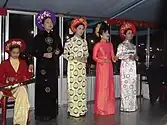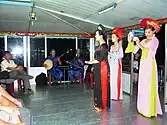Ca Huế
Ca Huế (Vietnamese: [kaː hwě], Chữ Hán: 歌化, "Huế songs") is a form of classical Vietnamese music of Central Vietnam, particularly the Huế region. It contrasts with the ca trù genre to the North, and the đờn ca tài tử "gifted scholar" style to the South. The singer sings solo, as in the ca trù genre, accompanying herself with small wooden clappers, sometimes similar to the phách sticks used in ca trù, sometimes shaped like small teacups.

Ca Huế Orchestra on Hương River
Ca Huế performance
Before and between the solo songs a traditional ensemble plays instrumental sections to complement the singer. The ca huế ensemble should be of five excellent instruments, ngũ tuyệt.[1]
References
- The Garland handbook of Southeast Asian music p269 Terry E. Miller, Sean Williams - 2008 "The ensemble accompanying ca huế is that of the "five excellent instruments" (ngũ tuyệt): a board zither, a two-stringed fiddle, a moon-shaped lute, a pear-shaped lute, and a three-stringed lute; a transverse flute can replace a lute."
This article is issued from Wikipedia. The text is licensed under Creative Commons - Attribution - Sharealike. Additional terms may apply for the media files.

